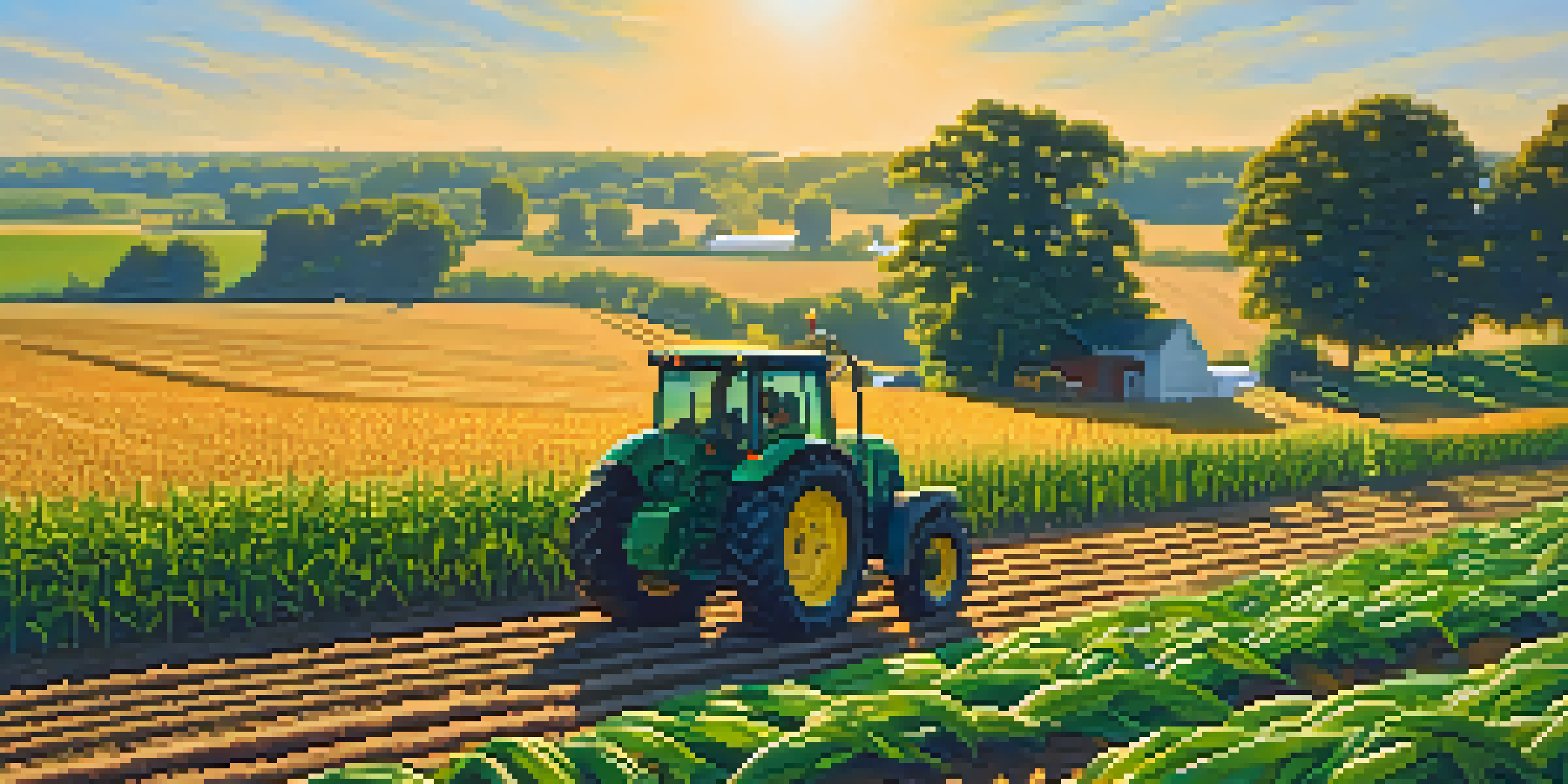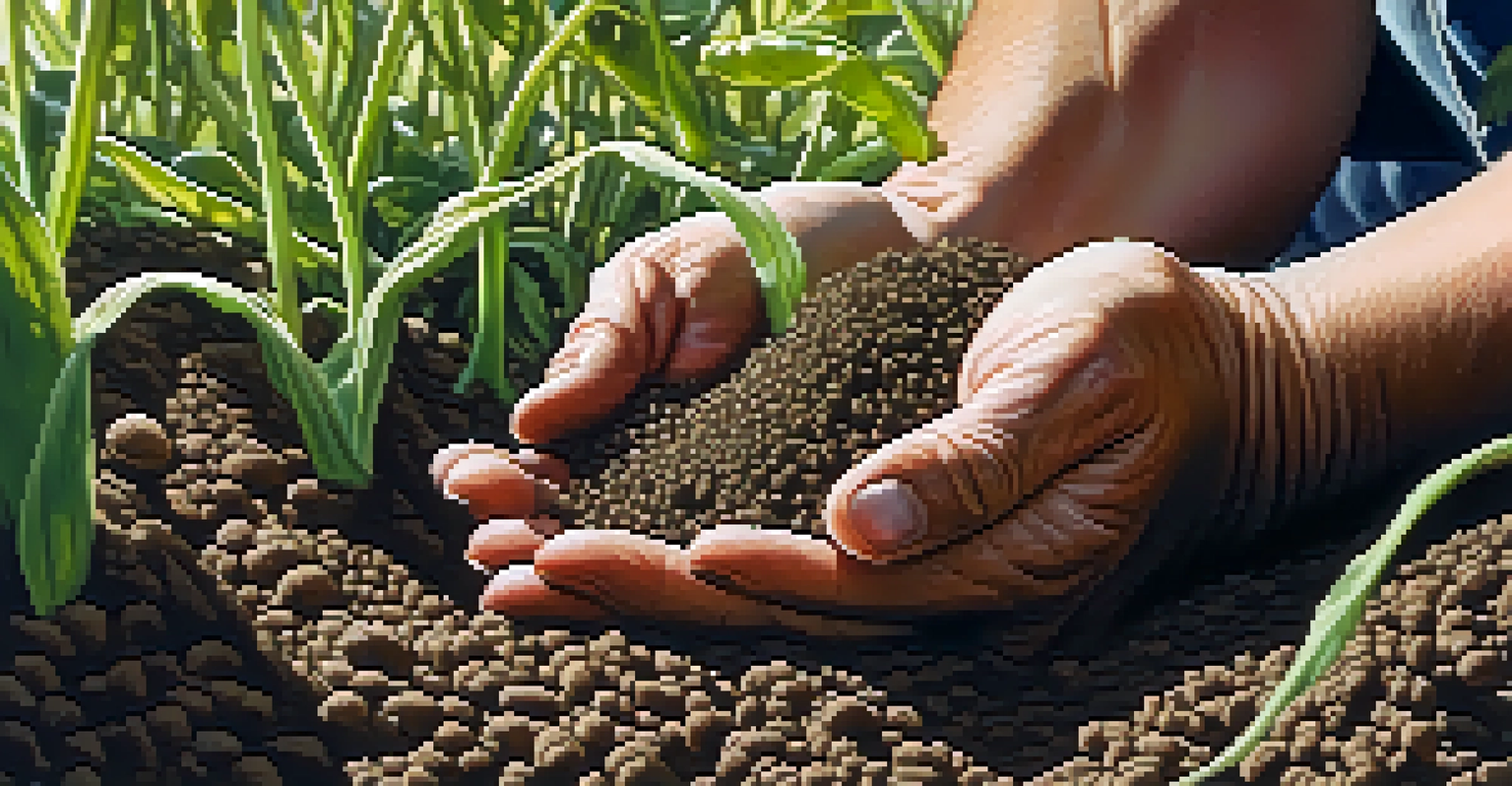Sustainable Farming Practices in Illinois Agriculture Sector

Introduction to Sustainable Farming in Illinois
Sustainable farming is becoming a buzzword in Illinois agriculture, as farmers seek ways to produce food while protecting the environment. This approach focuses on balancing ecological health, economic viability, and social equity. By employing sustainable practices, farmers not only contribute to a healthier ecosystem but also ensure the longevity of their farming operations.
Sustainable agriculture is a way of thinking about the future of farming, ensuring that we protect our land and resources for generations to come.
In Illinois, which is known for its vast corn and soybean fields, the shift toward sustainability has been gradual yet impactful. Farmers are recognizing that these practices are not just a trend but a necessity for future generations. As climate change and resource depletion become more pressing issues, the need for sustainable methods grows stronger.
The journey to sustainability often starts with education and community support. Organizations and research institutions in Illinois are providing resources and training to help farmers adopt these practices. The collective effort is creating a ripple effect, encouraging more farmers to rethink traditional methods and embrace sustainable alternatives.
Crop Rotation: A Key Sustainable Practice
One of the most effective sustainable practices in Illinois is crop rotation. This technique involves alternating different crops in the same field across growing seasons, which helps maintain soil health and reduce pest populations. For instance, planting legumes like soybeans can naturally replenish nitrogen levels in the soil, enhancing productivity.

Crop rotation minimizes the need for chemical fertilizers and pesticides, which can harm the environment. By diversifying crops, farmers can disrupt the life cycles of pests and diseases that often thrive on monocultures. This not only leads to healthier crops but also reduces dependency on chemical inputs, making farming more sustainable.
Adoption of Sustainable Practices
Farmers in Illinois are increasingly embracing sustainable farming methods to ensure environmental health and economic viability.
Farmers who have adopted crop rotation report not only improved yields but also lower operational costs. This practice illustrates how sustainable methods can be both environmentally friendly and economically beneficial. As more farmers witness these positive outcomes, crop rotation is becoming a cornerstone in the quest for sustainable agriculture in Illinois.
Cover Cropping for Soil Health
Cover cropping is another vital sustainable practice gaining traction among Illinois farmers. By planting crops such as clover or rye during the off-season, farmers can prevent soil erosion and improve soil fertility. Cover crops act as a protective blanket, keeping the soil intact and rich in nutrients.
The greatest threat to our planet is the belief that someone else will save it.
These crops also play a significant role in water retention, reducing runoff and promoting better moisture management. As climate patterns become increasingly unpredictable, maintaining healthy soil is crucial for resilient farming practices. Cover crops not only enhance soil structure but also support biodiversity in the agricultural ecosystem.
Farmers who utilize cover cropping often notice a marked improvement in their land’s productivity over time. This method exemplifies how simple changes can lead to significant environmental benefits. The growing adoption of cover crops in Illinois demonstrates a commitment to nurturing the land for future generations.
Integrated Pest Management (IPM) Explained
Integrated Pest Management, or IPM, is a holistic approach to managing pests in Illinois agriculture. Rather than relying solely on chemical pesticides, IPM combines various strategies, including biological controls, habitat manipulation, and cultural practices. This method aims to minimize pest populations while reducing the environmental impact of farming.
For instance, farmers might introduce beneficial insects that prey on harmful pests or use traps and pheromones to monitor pest levels. By understanding the ecosystem, farmers can make informed decisions that promote long-term pest control without harming beneficial species. This approach not only protects crops but also supports overall biodiversity.
Community Support Drives Change
Collaboration among local organizations and farmers is essential for promoting sustainable agriculture and fostering knowledge exchange.
IPM has proven to be a cost-effective and environmentally sound alternative to conventional pest management practices. As more farmers in Illinois adopt IPM, the agricultural landscape is shifting towards more sustainable methods. This practice showcases how innovation and ecological awareness can work hand-in-hand in modern farming.
Water Conservation Techniques in Agriculture
Water conservation is crucial in Illinois, especially as the state faces challenges related to climate change and water scarcity. Farmers are increasingly adopting techniques such as drip irrigation and rainwater harvesting to optimize water use. These methods not only conserve water but also improve crop yields by delivering moisture directly to the root zone.
Drip irrigation, for example, allows farmers to apply water more efficiently, reducing waste and evaporation. This targeted approach helps to maintain healthy plants while minimizing excess water usage. Rainwater harvesting systems capture and store rainwater, providing an additional water source for irrigation and other farm needs.
By implementing these water conservation practices, Illinois farmers are not only protecting a vital resource but also enhancing their resilience against drought conditions. The commitment to conserving water reflects a broader understanding of sustainability in agriculture. As awareness grows, more farmers are exploring innovative ways to manage water resources effectively.
Agroforestry: Blending Trees and Agriculture
Agroforestry is an innovative practice that combines agriculture and forestry to create more sustainable farming systems. In Illinois, farmers are integrating trees into their agricultural landscapes, providing multiple benefits such as increased biodiversity, improved soil health, and enhanced crop resilience. This practice creates a more balanced ecosystem that supports both crops and wildlife.
For example, planting trees along field edges can provide shade and shelter for crops, reduce wind erosion, and create habitats for beneficial insects. Additionally, the deep roots of trees help to improve soil structure and water retention. This symbiotic relationship between trees and crops illustrates the potential of agroforestry to enhance farm productivity.
Innovative Techniques Enhance Farming
Practices like crop rotation, cover cropping, and agroforestry are proving effective in improving soil health and reducing reliance on chemical inputs.
As more Illinois farmers explore agroforestry, the potential for increased sustainability becomes evident. This practice represents a shift towards a more holistic view of farming, where diverse ecosystems thrive alongside agricultural production. The growing interest in agroforestry highlights the importance of embracing innovative solutions in the agriculture sector.
Community Engagement in Sustainable Practices
Community engagement plays a vital role in promoting sustainable farming practices in Illinois. Local organizations, universities, and extension services are working together to provide resources, training, and support for farmers. This collaboration fosters a culture of sustainability, encouraging farmers to share their experiences and learn from one another.
Farmers’ markets, workshops, and field days are excellent platforms for knowledge exchange and community building. These events not only provide practical information but also help to strengthen local food systems. When farmers come together to discuss challenges and solutions, it creates a sense of camaraderie and shared purpose.

As more farmers in Illinois engage with their communities, the movement towards sustainable agriculture gains momentum. This collective effort highlights the importance of collaboration in achieving sustainability goals. By supporting one another, farmers can create a resilient agricultural landscape that benefits everyone.